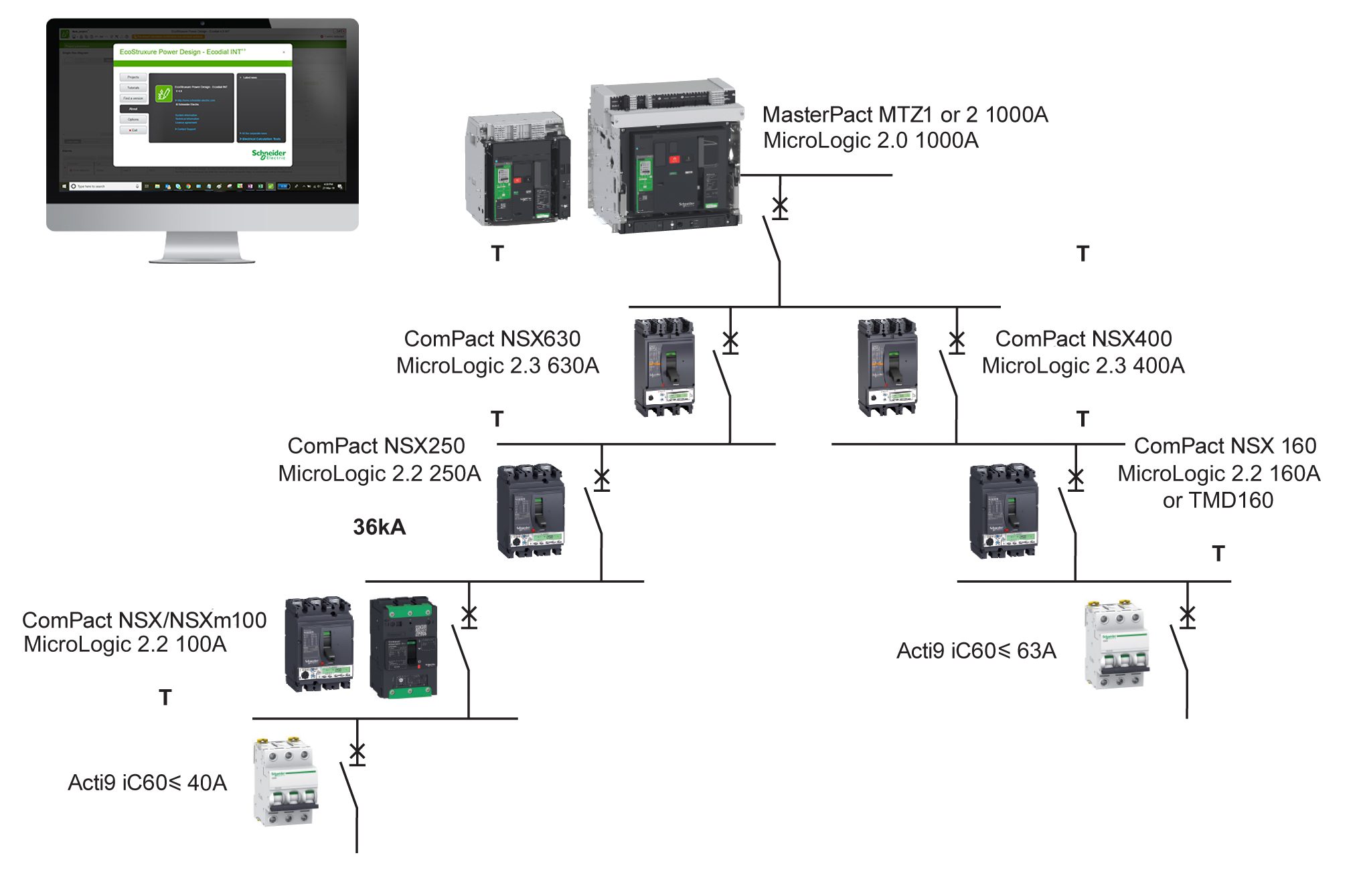Industrial plants, hospitals, data centers, and all types of facilities depend on reliable power to operate without interruptions. Even brief downtime caused by electrical issues can impact productivity, reduce customer satisfaction, and affect overall business performance. To minimize these risks, international standards such as IEC 60364 make selectivity mandatory for installations that supply safety services, while local regulations often require it in other applications as well.
Circuit breaker selectivity plays a key role in achieving this reliability. It makes sure that when a fault happens, the circuit breaker nearest to the issue disconnects, while the rest of the system continues operating. This level of coordination is achieved by designing protection devices to work together seamlessly, whether they are switches, contactors, circuit breakers, or Residual Current Devices (RCDs) in a switchboard. Without proper circuit breaker selectivity, a small fault could escalate into a full shutdown, creating unnecessary downtime.
By applying circuit breaker selectivity, facilities gain better safety, continuity of supply, and easier maintenance. It allows operators to protect critical systems while reducing the risk of complete power loss. For industries where uptime is essential, circuit breaker selectivity is not just a best practice but a crucial design requirement.
How does selectivity work?
Clearly, for facilities like hospitals, data centers, and airports it’s important to maintain up-time for all critical loads. But for applications like continuous industrial processes or food refrigeration, loss of power can result in costly damages in raw materials, products, and time. When an overload, short circuit, or ground fault occurs on a distribution circuit, energy availability should continue for all other parts of the electrical installation.
One solution is applying selectivity – sometimes called discrimination – between circuits. How does it work? If a fault condition occurs on a circuit, the circuit breaker closest to the fault will trip. The circuit breakers upstream from the tripped breaker remain unaffected, so power remains available to all other circuits and loads.
Additionally, it will be much faster for the facility team to locate and fix the source of the fault, as they simply need to identify the circuit where the one breaker has tripped. In contrast, if an upstream breaker had tripped, the fault could have happened any one of a number of downstream distribution circuits, so would take longer to locate.
Multiple levels of selectivity
It’s important that circuit breakers are designed to work together. In commercial buildings, for example, the function and rating of a circuit breaker depend on its position in the electrical architecture: air circuit breakers (ACB) or high rating molded case circuit breakers (MCCB) as incomer, with MCCBs middle level and miniature circuit breakers (MCB) for final circuits.
When considering the multiple levels, the quality of the installation will depend on how the products are designed to be coordinated together to manage the short circuit. This is difficult to assure when different brands of products are mixed together. Choosing products from a single manufacturer that has engineering teams working closely together can help ensure the best coordination.
In the case of a short-circuit at one point of the installation, we should keep in mind that all the circuit-breakers between the power supply (e.g. utility grid) and the fault will see an overcurrent. An ACB or high-rating MCCB main incomer may be delayed to achieve “time-based selectivity.” The challenge here is to define the right setting. For current limiting circuit breakers – this includes the majority of MCCBs on feeders and MCB in final distribution circuits – achieving selectivity is even trickier. It relies on the limitation of the let-through energy of all circuit-breakers involved as well as the non-tripping energy of the upstream circuit breaker. This needs to be considered during the design of breaking characteristics, and the tripping characteristics of the full range.
Thanks to close collaboration between our MCB, MCCB, and ACB design teams, Schneider Electric can offer an incomparable range of selective products, allowing architectures with several intermediate switchboards in order to optimize cable lengths.

Choosing circuit breakers for selectivity
More importantly, how do choose the right combination of circuits breakers and ratings so that selectivity works reliably?
Schneider Electric provides dedicated software (EcoStruxure Power Design), online tools, and a guide (Selectivity, Cascading and Coordination Guide) to support the design of a low voltage installation taking into consideration selectivity. Furthermore, having the correct products, such as MasterPact, ComPact, and Acti9 series circuit breakers offer a limited number of frame sizes and models to make this process even simpler. These breaker ranges are also designed and tested for selective coordination – from ACB to MCCB to MCB, as well as motor starters and motor circuit breakers – giving you the peace of mind that selectivity will perform, from mains to feeders to final distribution.
Benefits of circuit breaker selectivity
Circuit breaker selectivity is a vital part of electrical system design because it directly impacts safety, reliability, and performance. Here are the main benefits explained in detail:
- Enhanced safety
- Circuit breaker selectivity makes sure only the breaker closest to the fault trips. This limits the impact of the fault and keeps people and equipment protected.
- Uninterrupted power supply
- By isolating faults at the source, circuit breaker selectivity allows the rest of the system to keep running. This is critical in industries, hospitals, and data centers where downtime is not acceptable.
- Less downtime
- Since only the affected circuit is disconnected, overall downtime is reduced. This helps maintain productivity and lowers the financial cost of outages.
- Easier maintenance
- With circuit breaker selectivity, the exact fault location is clear because the tripping happens at the problem point. This makes repairs and troubleshooting faster.
- Regulatory compliance
- Many standards and local codes require circuit breaker selectivity for safety-related systems. Applying it ensures installations meet these requirements.
- Better system efficiency
- Properly coordinated breakers avoid nuisance tripping, extend equipment life, and improve overall system reliability.
Common applications and use cases
Circuit breaker selectivity is used in many industries and facilities where safety and uninterrupted power are essential. Here are some of the most common applications:
- Hospitals and healthcare facilities
- Circuit breaker selectivity ensures that critical medical equipment keeps running even if a fault occurs in a non-essential circuit. This prevents total power loss and protects patient safety.
- Data centers
- Data centers rely on circuit breaker selectivity to isolate faults to specific circuits or racks, keeping servers and network systems online without risking wide-scale outages.
- Industrial plants
- In manufacturing, circuit breaker selectivity prevents minor faults from stopping entire production lines, supporting continuous operations and reducing costly downtime.
- Commercial buildings
- Offices, malls, and campuses benefit because circuit breaker selectivity allows only the affected section to shut down, keeping lighting, elevators, and HVAC systems operational.
- Transportation systems
- Airports, railways, and metro networks use circuit breaker selectivity to maintain service while isolating faults in specific sections of complex electrical systems.
What are your thoughts? Continue the discussion on the Power Availability Forum.




Conversation
Mathieu,
This is an excellent article on the subject “power availability,” by ensuring the selection of “protective devices” with the “selectivity.”
The design engineers and specifiers, should participate this forum to get the benefit of it.
at the moment im taking the electrical course L3. Thanks for information given which is a great help for me to understand, the Protective Devices purpose, working and the selectivity of them before installing.